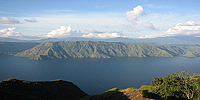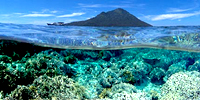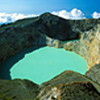|
|
The Wildlife Conservation and Nature Reserves
Permits are necessary to visit the nature reserve
which can be obtained from the PHPA office in Bogor or local offices.
Facilities in the reserves are generally undeveloped and mast travel
has to be done of foot or horseback. Some of the more important
ones are:
Krakatau
and Ujung Kulon
The total reserve area is 62,500 hectares and stands
570 metres above sea level.
By road from Jakarta or Bogor to Labuan on Java's west coast, or
by ferry from Sumatra (to Anyer, north of Labuan), and thence by
hired motorized fishing boat, taking a minimum of 5 hours from Labuan
to Peucang Island. Two rest houses on Peucang offer limited furnished
accommodation. Book first at the PHPA office at Labuan and take
canned food along.
The mainland reserve area is the last refuge for the 45-50 remaining
Java rhinos, and is almost the last lowland rain forest in Java.
Other wildlife species, gibbons, macaques, leaf monkeys, deer, pigs,
bantengs, (Java's wild ox), and 222 species of bird species.
Idyllic beaches, seascapes, and good coral. The Krakatau volcano,
40 kilometres from Labuan, is best visited from here on a one-day
trip. 
Gunung
Leuser
Gunung Leuser reserve is 830,500 hectares in size and 500 to 3,500
metres above sea level, and can be reached by road from Medan, North
Sumatra. Two research stations within the reserve function as an
Orangutan Rehabilitation Station, providing a rare opportunity to
see these great apes at close range.
A boat trip on the Alas River which flows through the reserve is
a good way to see the rain forest habitat of endangered species
of rhinos, orangutans, tigers and elephants. There are also gibbons,
leaf monkeys, jungle cats, forest deer, otters, hornbills and arguspheasants.
Serown (goat antelope) live in the mountain forests at higher altitude.

Semenanjung
Pangandaran
Only 100 metres high this reserve is only 530 hectares in size,
and can be reached by road from Bandung. Public transport, guest
house accommodation and food are all available. This reserve includes
beaches, coral gardens, caves and nature walks.
Intersting legends are associated with various topographical features.
There are remains of a Javanese World War 11 fortification. This
area is good for bird lovers. 
South
Sumatera
By road from Palembang or Tanjung Karang or from the Java Sumatra
ferry port at Bakauheni. The reserve area includes most of the south
western tip of Sumatra totaling 365,000 hectares, at a height of
1781 metres.
There are turtle rookeries on the western beach, Good forests both
at lowlands and mountains in the northern end of the reserve. Wildlife
includes gibbons, elephants, tapirs, pigs, deer and the occasional
tiger. 
Meru
Betiri
The reserve start at sea level and reaches 1,223 metres in an area
of 5 hectares. By (rough) road, go from Genteng or Glenmore, both
on the main Jember- Banyuwangi road. From Genteng, It's 70 kilometres
to the south coast where there is a rest house (bedding, food, service)
at Rajegwesi Bay, 2 kilometres from the reserve's eastern boundary.
Coffee plantations occupy much of the lowland and thick forests.
The steeper parts include precipitous headlands. Sukamade beach
is a fine turtle rookery of its kind. Two species of the parasitic
Rafflesia flower are fauna in Meru Betiri, which is the last refuge
for the nearly extinct Java tiger. 
Tongkolo
- Dua Saudara
The reserve starts at sea level and reaches 1,109 metres in an area
of 4,446 sq. metres.
By road from Manado, North Sulawesi across the peninsula to Bitting
harbour, then by boat. Two small guard posts within the reserve
offer basic shelter, food and camping equipment. There is interesting
volcanic scenery, and wildlife including anoas, macaques, babi-rusas,
tarsiers, pygmy squirels, cucusea (marsupial phalangers), and hornbills.
Megapode birds, lay their eggs in areas of volcanically heated sands.

Tanjung
Puting
The reserve covers 205,000 hectares at 30 metres above sea level.
By air from Banjarmasin, South Kalimantan to Pangkalan Bun, Central
Kalimantan (PHPA Office) and then by road to Kumai l 15 kilometres),
thense by boat on the Kumai and Sekunir Rivers into the reserve.
This is an interesting boat trip through swamp forest full of bird
life, particularly waterfowl; the Bornean proboscis monkeys, so
called from the large pendulous nose of the male, easily visible
in the riverine trees.
In the northern part of the resserve is a "rehabilitation station"
for Bornean orang utans which is also the study area of resident
scientists. There is a guest house at their camp. Advanced reservations
are necessary. Take canned food along. 
Bromo-Tengger-Semeru
The total area covers over 8,000 hectares at 1,500 to 3,676 metres
above sea level. Usually reached from the north by road from Pasuruan
to either Tosari or Ngadisari.
Both villages just below the rim of the Tengger crater offer some
accommodation as well as horses and guides. There is also a small
hotel at Cemara Lawang above Ngadisari keep track only). The floor
of the Tengger caldera is a vast "sand-sea" 10 kilometres
across. Cones of the active Bromo volcano and others rise from here.
Upland to the south shows three lakes, a small rest house at Mt.
Semeru, the highest mountain and still active volcano in Java. Though
under PHPA jurisdiction, no special permit is at present required
for a visit to this particular reserve. 
Lore
Kalamanta
The altitude ranges from 700 to 2,000 metres over an area of 131,000
hectares. By road from Palu, Central Sulawesi south to Kulawi 170
kilometres) or Gimpu l 130), then on foot with guides/hired porters,
camping gear and food stuffs over the 1800 metres ridge into the
valleys beyond.
There are no facilities, but accommodation can be found in occasional
villages of the Western Toraja people, who travel the paths into
and out of their isolated valleys regularly to trade. The reserve
includes fine lowland and mountain forests, many streams, much wildlife
especially the anoa (swarf buffalo), babi rusa, and black macaques.
Interesting megaliths are found in the valleys. 
Kutai
East-kalimantan
TheZoos reserve covers 200,000 hectares and goes up to 340
metres in altitude. By road from Samarinda, East Kalimantan to Sangata,
80 kilometres to the north, by boat up to the Sangata river. In
spite of timber exploitation and the logging access road, the reserve
still contains large areas of good lowland rain forests with except,
by request, those of timber companies near the coast.
Boat trips with side excursions by foot offer chances to see some
of the hardwood forests of East Kalimantan. 
The
Zoo
Jakarta's Ragunan Zoo is the best-landscaped zoo in Indonesia, providing
a close- to-native habitat for more than 3,600 animal and bird species,
among which are such protected species as the prehistoric giant
komodo lizard, the man-like orangutan ape, the babi-rusa and many
others.
Established in 1965, this zoo occupies an area of 185 hectares 1462,5
acres).
The Surabaya zoo in the Wonokromo district is deservedly second
in reputation to the Ragunan zoo, and like that of the latter its
collection of animals is considered to be among the most complete
in Southeast Asia. Of special interest in the Surabaya Zoo is the
section on nocturnal animals.
Smaller zoos are found in Yogyakarta, Bukittinggi and Bandung. The
first also serves as a botanic garden with species representative
of the local flora and those of other parts of Indonesia. The Bukittinggi
zoo presents a good sample of the local fauna of the area. 
|












